The Regime of Rural Ecotourism Stakeholders in Poverty-Stricken Areas of China: Implications for Rural Revitalization
Abstract
:1. Introduction
2. Literature Review
3. Model Building and Analysis
3.1. Analysis of the Interest Issues of Each Stakeholder
- (1)
- The game between government and tourism enterprises
- (2)
- The game between government and local residents
- (3)
- The game between tourism enterprises and local residents
3.2. Basic Game Hypothesis and Model Construction
3.3. Analysis of Evolution Game Model of Rural Ecotourism
3.3.1. Expected Return Function of Stakeholders in Rural Ecotourism
- (1)
- Equilibrium analysis of tourism enterprises
- (2)
- Equilibrium analysis of local residents
- (3)
- Equilibrium analysis of the government
3.3.2. Analysis of the Evolutionary Stabilization Strategy of Rural Ecotourism Stakeholders
- (1)
- Analysis of the replication dynamics of tourism companies
- ①
- When , the equation holds constant, which means that all levels are steady state, at which time the probability of strategy choice of tourism companies does not change over time.
- ②
- When , let , and , are two stable points. Derivative of gives: Due to , two scenarios can be discussed.
- (i)
- When and , and . Then is a stabilization strategy, and tourism companies will choose substantial rural ecotourism.
- (ii)
- When the above conditions are not met, the following two cases are classified. When , it can be concluded that and . Then is a stabilization strategy, and tourism companies will choose substantial rural ecotourism. When , it can be concluded that and . Then is a stabilization strategy, and tourism companies will choose spurious rural ecotourism.
- (2)
- Analysis of the replication dynamics of local residents
- ①
- When , the equation holds constant, which means that all levels are steady state, at which time the probability of strategy choice of local residents does not change over time.
- ②
- When , let , and and are two stable points. Derivative of gives: .Due to and , two scenarios can be discussed.
- (i)
- When , it can be concluded that and . Then is a stabilization strategy, and local residents will choose active participation.
- (ii)
- When the above conditions are not met, the following two cases are classified. When , it can be concluded that and . Then is a stabilization strategy, and local residents will choose active participation. When , it can be concluded that and . Then is a stabilization strategy, and local residents will choose negative participation.
- (3)
- Analysis of the replication dynamics of the government
- ①
- When , the equation holds constant, which means that all levels are steady state, at which time the probability of strategy choice of the government does not change over time.
- ②
- When , let , and an are two stable points. Derivative of gives: .Due to , two scenarios can be discussed.
- (i)
- When , it can be concluded that and . Then is a stabilization strategy, and the government will choose formal regulation.
- (ii)
- When the above conditions are not met, the following two cases are classified. When , it can be concluded that and . Then is a stabilization strategy, and the government will choose formal regulation. When , it can be concluded that and . Then is a stabilization strategy, and the government will choose strict regulation.
4. Case Analysis and Numerical Simulation
- (1)
- Strategy options for tourism enterprises in different initial states
- (2)
- Strategy choices of local residents in different initial states
- (3)
- The government’s choice of strategy in different initial states
- (4)
- The impact of differences in government awareness and local residents’ ability to understand on the evolution of local residents’ strategies
- (5)
- The impact of differences in income from other activities of local residents on the evolution of local residents’ strategies
- (6)
- The impact of the difference in the probability of being detected by the government when tourism enterprises engage in bogus rural ecotourism on the evolution of government strategies
- (7)
- The impact of differences in the probability of being detected by the government when tourism enterprises spuriously undertake rural ecotourism on the evolution of tourism enterprise strategies
5. Conclusions and Policy Recommendations
5.1. Conclusions
- (1)
- The different initial game states lead to different evolutionary stability strategy (ESS), with the final choice of which strategy depends on the probability of the various strategies initially chosen. In the long run, an ideal stable state is one in which tourism enterprises substantially undertake rural ecotourism, local residents actively participate, and the government strictly regulates.
- (2)
- When the government’s promotion of rural ecotourism policies is low, or local residents have a low understanding of the policies, local residents will choose to participate negatively. Only when the government’s support policies is high, and local residents have a thorough understanding of rural eco-tourism policies, can local residents be promoted to actively participate in rural eco-tourism activities and contribute to rural revitalization.
- (3)
- Local residents may engage in other activities while participating in rural ecotourism projects, such as selling agricultural and sideline products, making special handicrafts, etc. If the income from these activities is low, local residents will choose to actively participate in rural eco-tourism projects; if the income from these activities is high, local residents will choose to negatively participate in rural ecotourism projects.
- (4)
- When the probability of a tourism enterprise engaging in false rural ecotourism is low and the government discovers this behavior, the tourism enterprise will choose the fake strategy and the government will choose the formal regulation; as the probability of discovery increases, the tourism enterprise will choose the substantial rural ecotourism strategy and the government will choose the strict regulation strategy.
5.2. Theoretical Contribution
5.3. Practical Implications
- (1)
- For the government, it is necessary to increase the publicity and promotion of relevant rural ecotourism policies, so as to enhance local residents’ awareness of the relevant policies; increase the incentives for local residents of active participation; increase the incentives for enterprises that substantially implement rural ecotourism and the penalties for enterprises that falsely implement rural ecotourism; and improve the monitoring system to dynamically monitor the implementation of rural ecotourism projects by enterprises. It will increase the likelihood of fraudulent rural ecotourism projects being detected by tourism companies. The government should place rural revitalization in a prominent position, take the construction of a rural revitalization demonstration belt as an important grasp, plan carefully, highlight the characteristics according to local conditions, make full use of the linkage and radiation of the surrounding characteristic towns, and build a rural revitalization demonstration village with high standards. In addition, the local government should establish a fast and smooth information network, adopt modern information means such as e-commerce, negotiate projects through the Internet and other forms, and strive to expand online investment, while implementing entrusted investment or intermediary investment.
- (2)
- For tourism enterprises, the pursuit of profit maximize is their goal. However, rural ecotourism projects are heavily invested, and because returns are difficult and slow to achieve in the short term, tourism enterprises may be reluctant to undertake substantive implementation of rural ecotourism projects. If tourism enterprises falsely implement rural ecotourism projects, they will suffer a loss of overall social benefits. Therefore, tourism enterprises should also take social responsibility, have a long-term vision and respond to the government’s call to implement rural ecotourism projects for local residents, so as to better serve rural revitalization.
- (3)
- For local residents, they should change their traditional concepts, actively learn about the relevant rural ecotourism policies, and actively participate in rural ecotourism projects with the help of the government and tourism enterprises, so as to successfully realize their own poverty alleviation and re-employment, improve their own skills and meet the needs of rural revitalization. At the same time, based on the actual demand for the development and operation of rural eco-tourism resources, local residents are provided with skills training in the dissemination of rural eco-tourism cultural resources, the transmission of special skills and the operation of B&Bs, so as to expand the audience for vocational education and strengthen the effectiveness of vocational education.
5.4. Limitations and Future Research
Author Contributions
Funding
Data Availability Statement
Conflicts of Interest
Disclosure Statement
References
- Cawley, M.; Gillmor, D.A. Integrated rural tourism: Concepts and Practice. Ann. Tour. Res. 2008, 35, 316–337. [Google Scholar] [CrossRef]
- Lane, B. Rural Tourism: An Overview. In The SAGE Handbook of Tourism Studies; SAGE Publications Ltd.: Thousand Oaks, CA, USA, 2012; pp. 355–371. [Google Scholar]
- Martínez, J.M.G.; Martín, J.M.M.; Fernández, J.A.S.; Mogorrón-Guerrero, H. An analysis of the stability of rural tourism as a desired condition for sustainable tourism. J. Bus. Res. 2019, 100, 165–174. [Google Scholar] [CrossRef]
- Yang, J.; Yang, R.; Chen, M.H.; Su, C.H.; Zhi, Y.; Xi, J. Effects of rural revitalization on rural tourism. J. Hosp. Tour. Manag. 2021, 47, 35–45. [Google Scholar] [CrossRef]
- Gao, J.; Wu, B. Revitalizing traditional villages through rural tourism: A case study of Yuanjia Village, Shaanxi Province, China. Tour. Manag. 2017, 63, 223–233. [Google Scholar] [CrossRef]
- Su, B. Rural tourism in China. Tour. Manag. 2011, 32, 1438–1441. [Google Scholar] [CrossRef]
- Chi, X.; Han, H. Emerging rural tourism in China’s current tourism industry and tourist behaviors: The case of Anji County. J. Travel Tour. Mark. 2021, 38, 58–74. [Google Scholar] [CrossRef]
- Su, M.M.; Wall, G.; Wang, Y.; Jin, M. Livelihood sustainability in a rural tourism destination—Hetu Town, Anhui Province, China. Tour. Manag. 2019, 71, 272–281. [Google Scholar] [CrossRef]
- Zeng, B.; Wang, C. Research progress in corporate social responsibility in the context of ‘tourism-assisting the poor’in China. J. China Tour. Res. 2019, 15, 379–401. [Google Scholar] [CrossRef]
- Cappelli, A.; Cini, E. Challenges and Opportunities in Wheat Flour, Pasta, Bread, and Bakery Product Production Chains: A Systematic Review of Innovations and Improvement Strategies to Increase Sustainability, Productivity, and Product Quality. Sustainability 2021, 13, 2608. [Google Scholar] [CrossRef]
- Cappelli, A.; Lupori, L.; Cini, E. Baking technology: A systematic review of machines and plants and their effect on final products, including improvement strategies. Trends Food Sci. Technol. 2021, 115, 275–284. [Google Scholar] [CrossRef]
- Liu, C.; Dou, X.; Li, J.; Cai, L.A. Analyzing government role in rural tourism development: An empirical investigation from China. J. Rural. Stud. 2020, 79, 177–188. [Google Scholar] [CrossRef]
- Jiang, X.; Song, X.; Zhao, H.; Zhang, H. Rural Tourism Network Evaluation Based on Resource Control Ability Analysis: A Case Study of Ning’an, China. Land 2021, 10, 427. [Google Scholar] [CrossRef]
- Li, W.; Zhou, Y.; Zhang, Z. Strategies of Landscape Planning in Peri-Urban Rural Tourism: A Comparison between Two Villages in China. Land 2021, 10, 277. [Google Scholar] [CrossRef]
- Lun, Y.; Jing, S.; Moucheng, L.; Qingwen, M. Agricultural production under rural tourism on the Qinghai-Tibet Plateau: From the perspective of smallholder farmers. Land Use Policy 2021, 103, 105329. [Google Scholar] [CrossRef]
- Pan, Y.; Wang, X.; Ryan, C. Chinese seniors holidaying, elderly care, rural tourism and rural poverty alleviation programmes. J. Hosp. Tour. Manag. 2021, 46, 134–143. [Google Scholar] [CrossRef]
- Mahadevan, R.; Suardi, S.; Ji, C.; Hanyu, Z. Is urbanization the link in the tourism–poverty nexus? Case study of China. Curr. Issues Tour. 2021. [Google Scholar] [CrossRef]
- Deng, A.; Lu, J.; Zhao, Z. Rural destination revitalization in China: Applying evolutionary economic geography in tourism governance. Asia Pac. J. Tour. Res. 2021, 26, 215–230. [Google Scholar] [CrossRef]
- Ruiz-Real, J.L.; Uribe-Toril, J.; Valenciano, J.D.P.; Gázquez-Abad, J.C. Rural tourism and development: Evolution in Scientific Literature and Trends. J. Hosp. Tour. Res. 2020. [Google Scholar] [CrossRef]
- Cheng, L.; Xu, J. Benefit-sharing and residents’ subjective well-being in rural tourism: An asymmetric approach. J. Destin. Mark. Manag. 2001, 21, 100631. [Google Scholar]
- He, Y.; Huang, P.; Xu, H. Simulation of a dynamical ecotourism system with low carbon activity: A case from western China. J. Environ. Manag. 2018, 206, 1243–1252. [Google Scholar] [CrossRef]
- Zhang, J. Evaluating regional low-carbon tourism strategies using the fuzzy Delphi- analytic network process approach. J. Clean. Prod. 2017, 141, 409–419. [Google Scholar] [CrossRef]
- Schweinsberg, S.; Darcy, S.; Wearing, S.L. Repertory grids and the measurement of levels of community support for rural ecotourism development. J. Ecotourism 2018, 17, 239–251. [Google Scholar] [CrossRef]
- Wang, J.; Liu, Y.; Li, Y. Ecological restoration under rural restructuring: A case study of Yan’an in China’s loess plateau. Land Use Policy 2019, 87, 104087. [Google Scholar] [CrossRef]
- Newton, J.; Franklin, A. Delivering sustainable communities in China: Using a sustainable livelihoods framework for reviewing the promotion of “ecotourism” in Anji. Local Environ. 2011, 16, 789–806. [Google Scholar] [CrossRef]
- Sanagustín-Fons, M.V.; Fierro, J.A.M.; Patiño, M.G.G. Rural tourism: A sustainable alternative. Appl. Energy 2011, 88, 551–557. [Google Scholar] [CrossRef]
- Shi, F.; Weaver, D.; Zhao, Y.; Huang, M.-F.; Tang, C.; Liu, Y. Toward an ecological civilization: Mass comprehensive ecotourism indications among domestic visitors to a Chinese wetland protected area. Tour. Manag. 2019, 70, 59–68. [Google Scholar] [CrossRef]
- Shang, Y.; Sun, Y.; Xu, A. Rural ecotourism planning and design based on SWOT analysis. Int. J. Low-Carbon Technol. 2020, 15, 368–372. [Google Scholar] [CrossRef]
- Chen, Z. Study on the Problems and Countermeasures of the Development of Rural Ecotourism in China. J. Adv. Econ. Financ. 2019, 4, 43. [Google Scholar] [CrossRef]
- Lee, J.-H.; Choi, H.O. Stakeholders’ views on reducing financial support in government-led ecotourism areas. Ocean Coast. Manag. 2017, 144, 7–15. [Google Scholar] [CrossRef]
- Lee, J.-H.; Son, Y.-H. Stakeholder Subjectives Toward Ecotourism Development using Q methodology: The Case of Maha Ecotourism Site in Pyeongchang, Korea. Asia Pac. J. Tour. Res. 2015, 21, 931–951. [Google Scholar] [CrossRef]
- Wang, W.; Feng, L.; Zheng, T.; Liu, Y. The sustainability of ecotourism stakeholders in ecologically fragile areas: Implications for cleaner production. J. Clean. Prod. 2021, 279, 123606. [Google Scholar] [CrossRef]
- Massingham, E.; Fuller, R.A.; Dean, A.J. Pathways between contrasting ecotourism experiences and conservation engagement. Biodivers. Conserv. 2019, 28, 827–845. [Google Scholar] [CrossRef]
- Withanachchi, S.; Kunchulia, I.; Ghambashidze, G.; Al Sidawi, R.; Urushadze, T.; Ploeger, A. Farmers’ Perception of Water Quality and Risks in the Mashavera River Basin, Georgia: Analyzing the Vulnerability of the Social-Ecological System through Community Perceptions. Sustainability 2018, 10, 3062. [Google Scholar] [CrossRef] [Green Version]
- Al Sidawi, R.; Urushadze, T.; Ploeger, A. Factors and Components Affecting Dairy Smallholder Farmers and the Local Value Chain—Kvemo Kartli as an Example. Sustainability 2021, 13, 5749. [Google Scholar] [CrossRef]
- Su, M.M.; Wall, G.; Ma, Z. Assessing Ecotourism from a Multi-stakeholder Perspective: Xingkai Lake National Nature Reserve, China. Environ. Manag. 2014, 54, 1190–1207. [Google Scholar] [CrossRef]
- Font, X.; Garay, L.; Jones, S. Sustainability motivations and practices in small tourism enterprises in European protected areas. J. Clean. Prod. 2016, 137, 1439–1448. [Google Scholar] [CrossRef]
- Font, X.; Garay, L.; Jones, S. A Social Cognitive Theory of sustainability empathy. Ann. Tour. Res. 2016, 58, 65–80. [Google Scholar] [CrossRef]
- Margaryan, L.; Stensland, S. Sustainable by nature? The case of (non)adoption of eco-certification among the nature-based tourism companies in Scandinavia. J. Clean. Prod. 2017, 162, 559–567. [Google Scholar] [CrossRef]
- Mzembe, A.N.; Lindgreen, A.; Idemudia, U.; Melissen, F. A club perspective of sustainability certification schemes in the tourism and hospitality industry. J. Sustain. Tour. 2020, 28, 1332–1350. [Google Scholar] [CrossRef]
- Diamantis, D. Stakeholder ecotourism management: Exchanges, coordination’s and adaptations. J. Ecotourism 2018, 17, 203–205. [Google Scholar] [CrossRef] [Green Version]
- Wondirad, A.; Tolkach, D.; King, B. Stakeholder collaboration as a major factor for sustainable ecotourism development in developing countries. Tour. Manag. 2020, 78, 104024. [Google Scholar] [CrossRef]
- Neger, C. Ecotourism in crisis: An analysis of the main obstacles for the sector’s economic sustainability. J. Ecotourism 2021. [Google Scholar] [CrossRef]
- Wang, M.Y.; Li, Y.; Cheng, Z.; Zhong, C.; Ma, W. Evolution and equilibrium of a green technological innovation system: Simulation of a tripartite game model. J. Clean. Prod. 2021, 278, 123944. [Google Scholar] [CrossRef]
- Jing-Ming, H.E. A Study on Rural Tourism Overseas. Tour. Trib. 2003, 18, 76–80. [Google Scholar]
- Yagüe, P. Rural tourism in Spain. Ann. Tour. Res. 2002, 29, 1101–1110. [Google Scholar] [CrossRef]
- Carlisle, S.; Kunc, M.; Jones, E.; Tiffin, S. Supporting innovation for tourism development through multi-stakeholder approaches: Experiences from Africa. Tour. Manag. 2013, 35, 59–69. [Google Scholar] [CrossRef]
- Thelen, T.; Kim, S.; Scherer, E. Film tourism impacts: A multi-stakeholder longitudinal approach. Tour. Recreat. Res. 2020, 45, 291–306. [Google Scholar] [CrossRef]
- Chi, J.; Cui, F.J. A Study on “The Tragedy of the Commons” in the Process of the Development of On-limits Rural Tourism Destinations—A Case of Meijiawu, Longwu and Shangougou in Hangzhou. Tour. Tribune 2006, 7, 17–23. [Google Scholar]
- Xue, L.; Kerstetter, D.; Hunt, C. Tourism development and changing rural identity in China. Ann. Tour. Res. 2017, 66, 170–182. [Google Scholar] [CrossRef]
- Chen, J.; Guan, J.; Xu, J.; Clergeau, C. Constructing the Green Supply Chain for Rural Tourism in China: Perspective of Front–Back Stage Decoupling. Sustainability 2018, 10, 4276. [Google Scholar] [CrossRef] [Green Version]
- Garry, S.; Oddone, N. Strengthening tourism value chains in rural settings. Rural industrial policy and strengthening value chains. Econ. Dev. 2017, 145, 195. [Google Scholar]
- Rosalina, P.D.; Dupre, K.; Wang, Y. Rural tourism: A systematic literature review on definitions and challenges. J. Hosp. Tour. Manag. 2021, 47, 134–149. [Google Scholar] [CrossRef]
- Wang, L.-E.; Cheng, S.-K.; Zhong, L.-S.; Mu, S.-L.; Dhruba, B.G.C.; Ren, G.-Z. Rural tourism development in China: Principles, models and the future. J. Mt. Sci. 2013, 10, 116–129. [Google Scholar] [CrossRef] [Green Version]
- Yin, M.H.; Wang, Q.; Yang, X.Z.; Si, X.X. The type and model of regional pro-poor tourism—A case study of 36 counties in Dabie Mountain contiguous destitute areas. Econ. Geogr. 2018, 38, 215–224. [Google Scholar]
- Wang, Q.S.; Zhang, X.F.; Guo, J. Research on rural tourism poverty alleviation model and path optimization based on symbiosis theory: A case of Zhuquan Village, Yinan County, Shandong Province. Areal Res. Dev. 2019, 38, 108–112. [Google Scholar]
- Wang, D.Q.; Li, W.; Yue, J. A study on the mode of tourism poverty alleviation in Yunnan traditional farming areas—Taking Weishan County as an example. World Reg. Stud. 2020, 29, 214–222. [Google Scholar]
- Deng, T.; Li, X.; Ma, M. Evaluating impact of air pollution on China’s inbound tourism industry: A spatial econometric approach. Asia Pac. J. Tour. Res. 2017, 22, 771–780. [Google Scholar] [CrossRef]
- Croes, R.; Rivera, M.A. Tourism’s potential to benefit the poor: A social accounting matrix model applied to Ecuador. Tour. Econ. 2017, 23, 29–48. [Google Scholar] [CrossRef]
- Liang, Y.; Shi, C. Efficiency evaluation and optimization of rural ecotourism space based on DEA model. Int. J. Low-Carbon Technol. 2020, 15, 356–360. [Google Scholar] [CrossRef]
- Yang, J.; Wu, Y.; Wang, J.; Wan, C.; Wu, Q. A Study on the Efficiency of Tourism Poverty Alleviation in Ethnic Regions Based on the Staged DEA Model. Front. Psychol. 2021, 12, 970. [Google Scholar]
- Llorca-Rodríguez, C.M.; Casas-Jurado, A.C.; García-Fernández, R.M. Tourism and poverty alleviation: An empirical analysis using panel data on Peru’s departments. Int. J. Tour. Res. 2017, 19, 746–756. [Google Scholar] [CrossRef]
- Cater, E. Ecotourism in the Third World: Problems and prospects for sustainability. Ecotourism: A sustainable option? Tour. Manag. 1994, 14, 69–86. [Google Scholar]
- Blangy, S.; Wood, M.E. Developing and Implementing Ecotourism Guidelines for Wildlands and Neighboring Communities; Ecotourism Society: New Bennington, VT, USA, 1993; pp. 32–54. [Google Scholar]
- Xiang, C.; Yin, L. Study on the rural ecotourism resource evaluation system. Environ. Technol. Innov. 2020, 20, 101131. [Google Scholar] [CrossRef]
- Phelan, A.; Ruhanen, L.; Mair, J. Ecosystem services approach for community-based ecotourism: Towards an equitable and sustainable blue economy. J. Sustain. Tour. 2020, 28, 1665–1685. [Google Scholar] [CrossRef]
- Motlagh, E.Y.; Hajjarian, M.; Zadeh, O.H.; Alijanpour, A. The difference of expert opinion on the forest-based ecotourism development in developed countries and Iran. Land Use Policy 2020, 94, 104549. [Google Scholar] [CrossRef]
- Hagenlocher, M.; Renaud, F.G.; Haas, S.; Sebesvari, Z. Vulnerability and risk of deltaic social-ecological systems exposed to multiple hazards. Sci. Total Environ. 2018, 631–632, 71–80. [Google Scholar] [CrossRef] [PubMed] [Green Version]
- Lo, M.-C.; Ramayah, T.; Hui, H.L.H. Rural Communities Perceptions and Attitudes towards Environment Tourism Development. J. Sustain. Dev. 2014, 7, 84. [Google Scholar] [CrossRef] [Green Version]
- Lee, T.H.; Jan, F.-H. Ecotourism Behavior of Nature-Based Tourists: An Integrative Framework. J. Travel Res. 2018, 57, 792–810. [Google Scholar] [CrossRef]
- Passafaro, P. Attitudes and Tourists’ Sustainable Behavior: An Overview of the Literature and Discussion of Some Theoretical and Methodological Issues. J. Travel Res. 2019, 59, 579–601. [Google Scholar] [CrossRef]
- Lee, J.-H. Conflict mapping toward ecotourism facility foundation using spatial Q methodology. Tour. Manag. 2019, 72, 69–77. [Google Scholar] [CrossRef]
- Friedman, D. On economic applications of evolutionary game theory. J. Evol. Econ. 1998, 8, 15–43. [Google Scholar] [CrossRef] [Green Version]
- Chiong, R.; Jovanovic, J. Collaborative Learning in Online Study Groups: An Evolutionary Game Theory Perspective. J. Inf. Technol. Educ. Res. 2012, 11, 81–101. [Google Scholar] [CrossRef]
- Tian, Z.; Gao, X.; Su, S.; Qiu, J.; Du, X.; Guizani, M. Evaluating Reputation Management Schemes of Internet of Vehicles Based on Evolutionary Game Theory. IEEE Trans. Veh. Technol. 2019, 68, 5971–5980. [Google Scholar] [CrossRef] [Green Version]
- Ji, P.; Ma, X.; Li, G. Developing green purchasing relationships for the manufacturing industry: An evolutionary game theory perspective. Int. J. Prod. Econ. 2015, 166, 155–162. [Google Scholar] [CrossRef]
- Tian, Y.; Govindan, K.; Zhu, Q. A system dynamics model based on evolutionary game theory for green supply chain management diffusion among Chinese manufacturers. J. Clean. Prod. 2014, 80, 96–105. [Google Scholar] [CrossRef]
- Lin, D.-Y.; Juan, C.-J.; Ng, M. Evaluation of green strategies in maritime liner shipping using evolutionary game theory. J. Clean. Prod. 2021, 279, 123268. [Google Scholar] [CrossRef]
- Zhao, L.; Chen, Z.; Liu, J. Evolutionary game theory between local government and tourism enterprises in the context of a low-carbon economy. Tour. Trib. 2015, 30, 72–82. [Google Scholar]
- Qingyun, P.; Mu, Z. Evolutionary game analysis of land income distribution in tourism development. Tour. Econ. 2021, 27, 670–687. [Google Scholar] [CrossRef]
- Bu, Y.; Wang, E.; Yu, Y. Analysis on asymptotic stabilization of eco-compensation program for forest ecotourism stakeholders. Environ. Sci. Pollut. Res. 2021, 28, 29304–29320. [Google Scholar] [CrossRef]
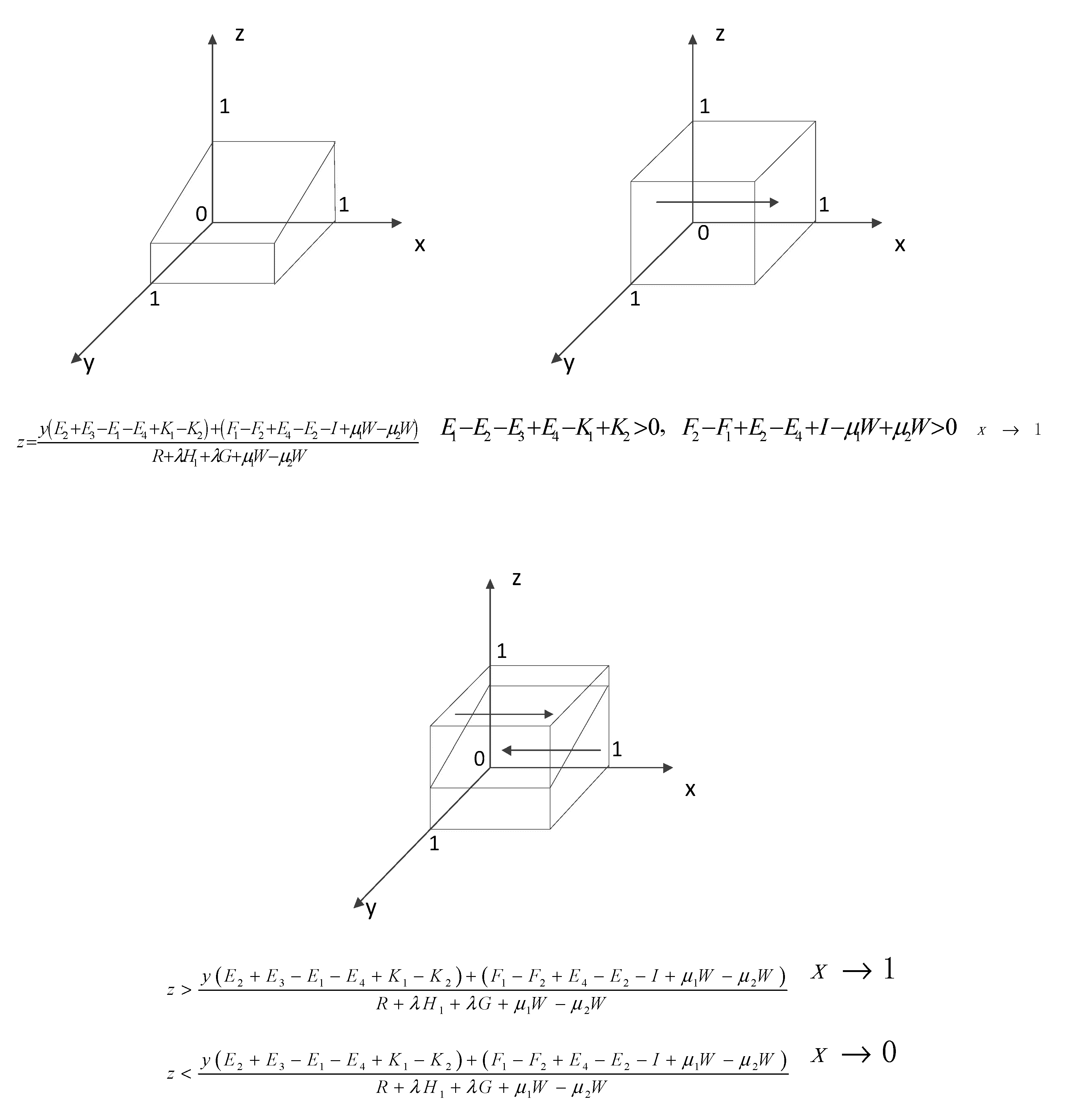
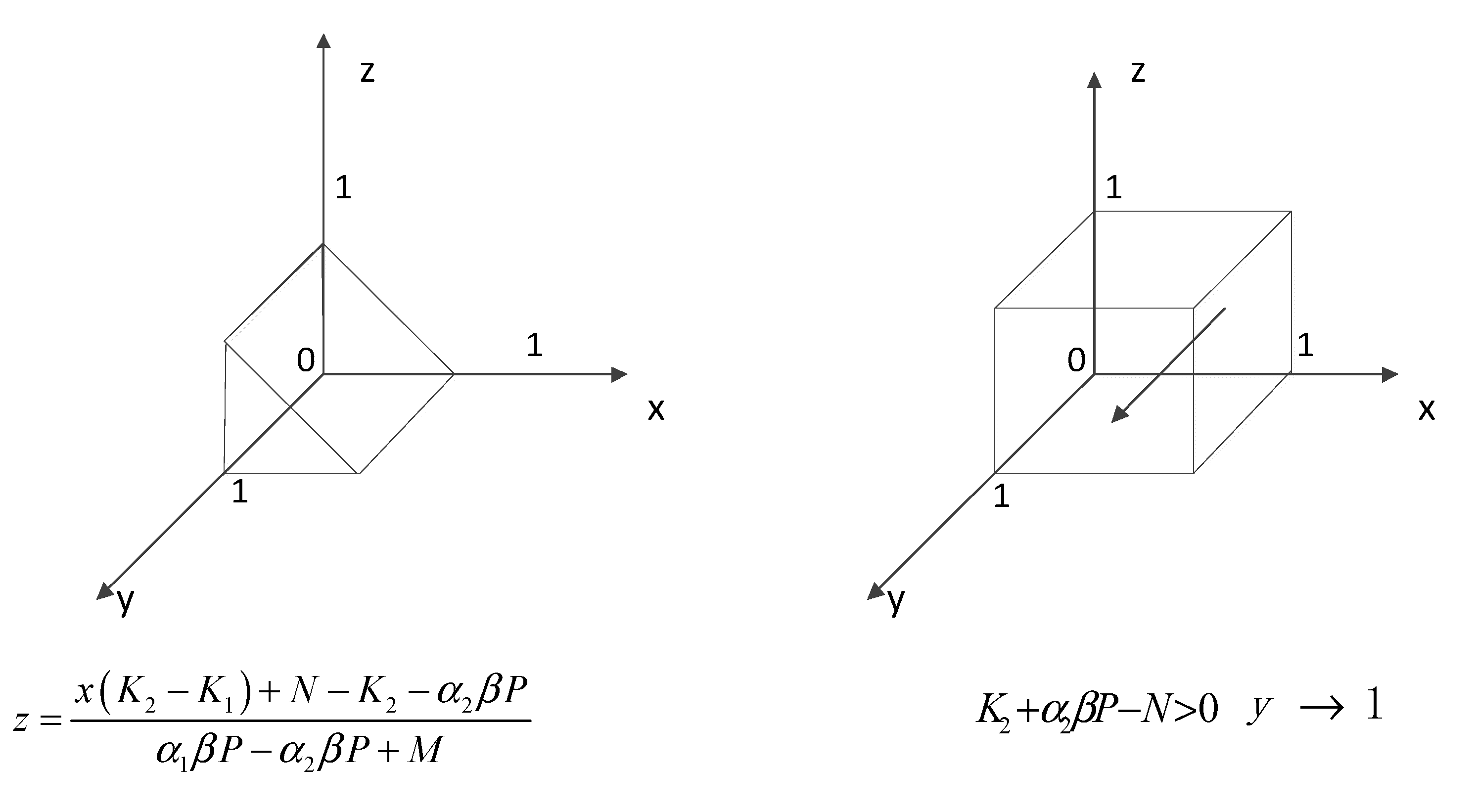
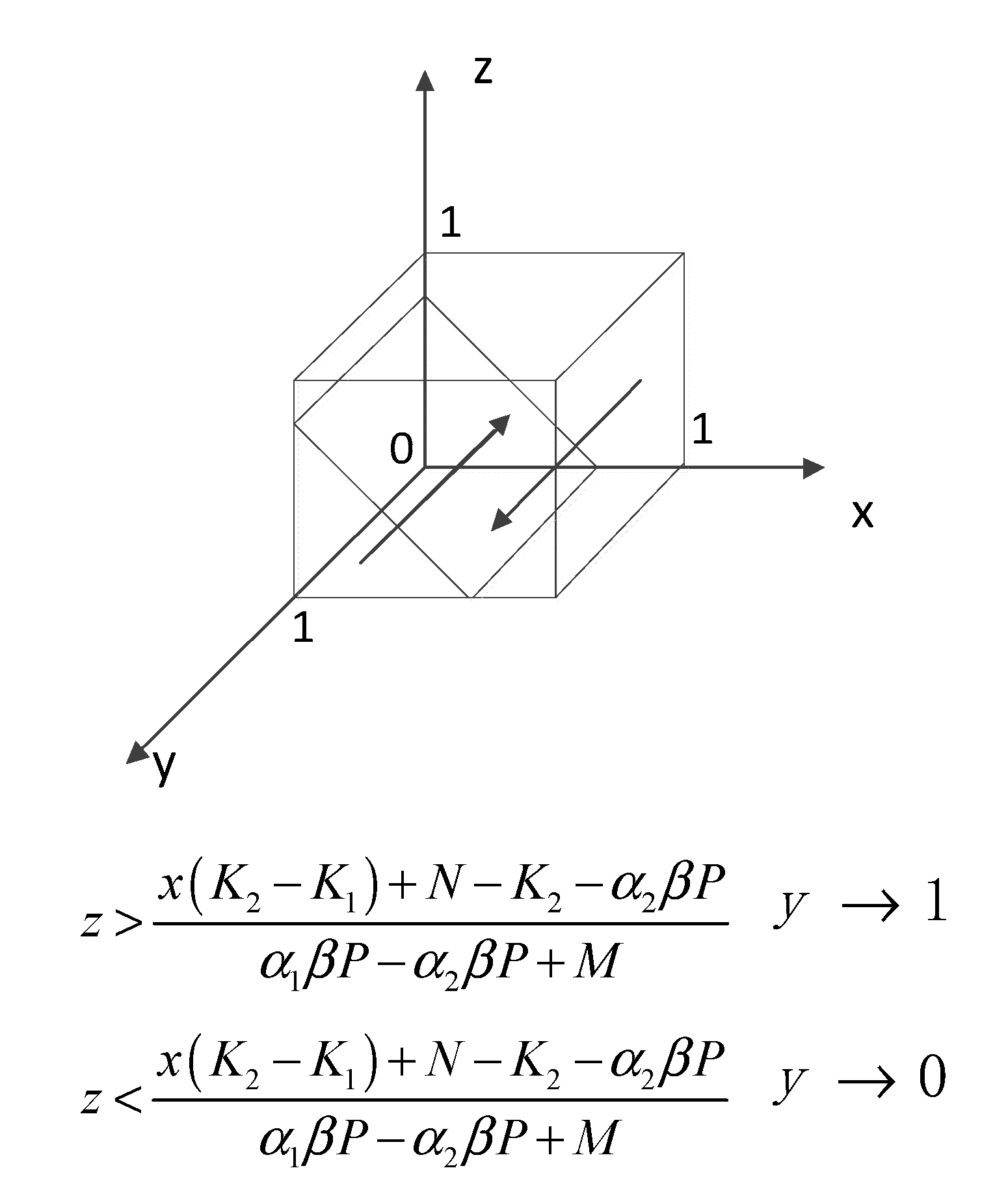
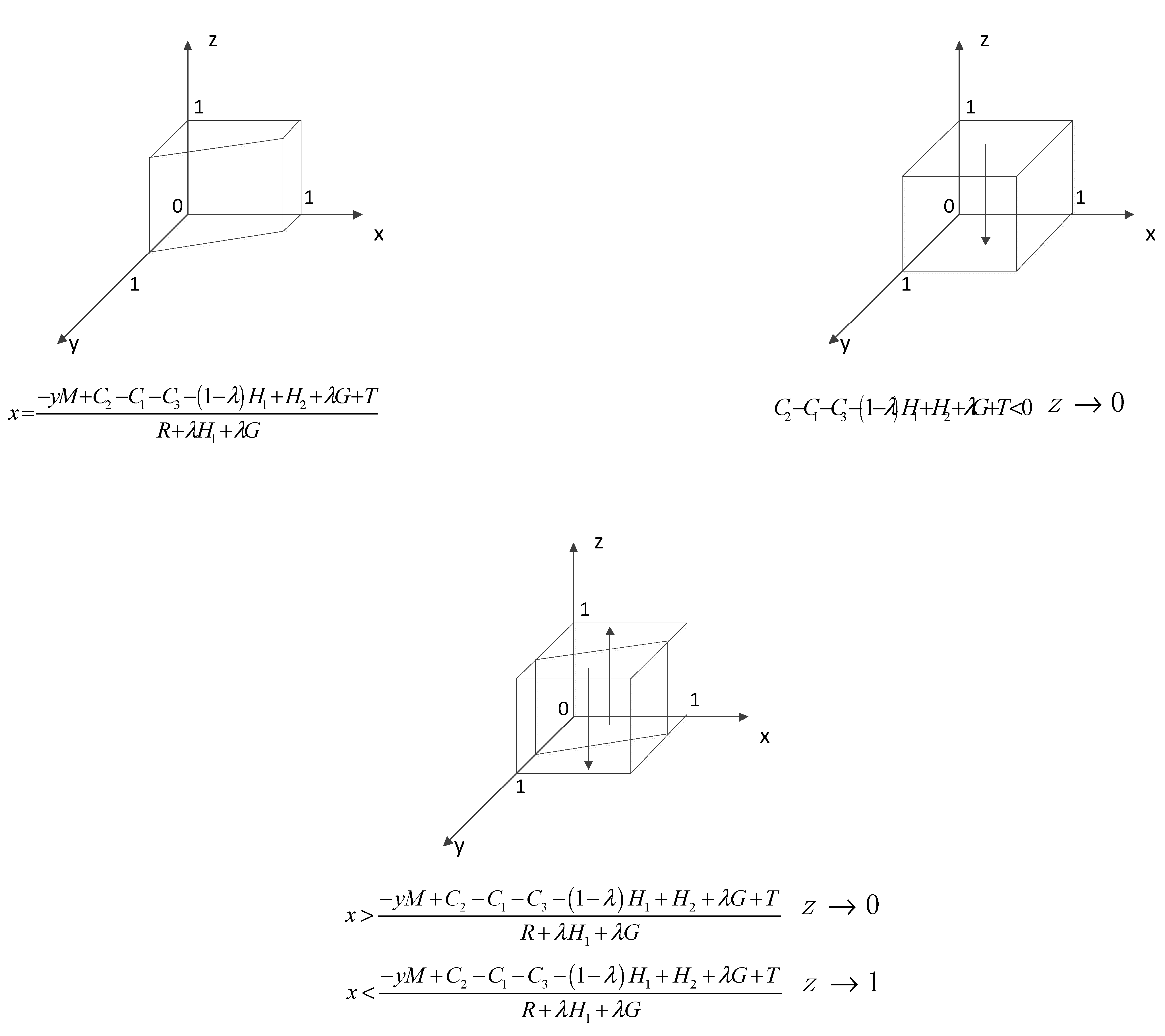
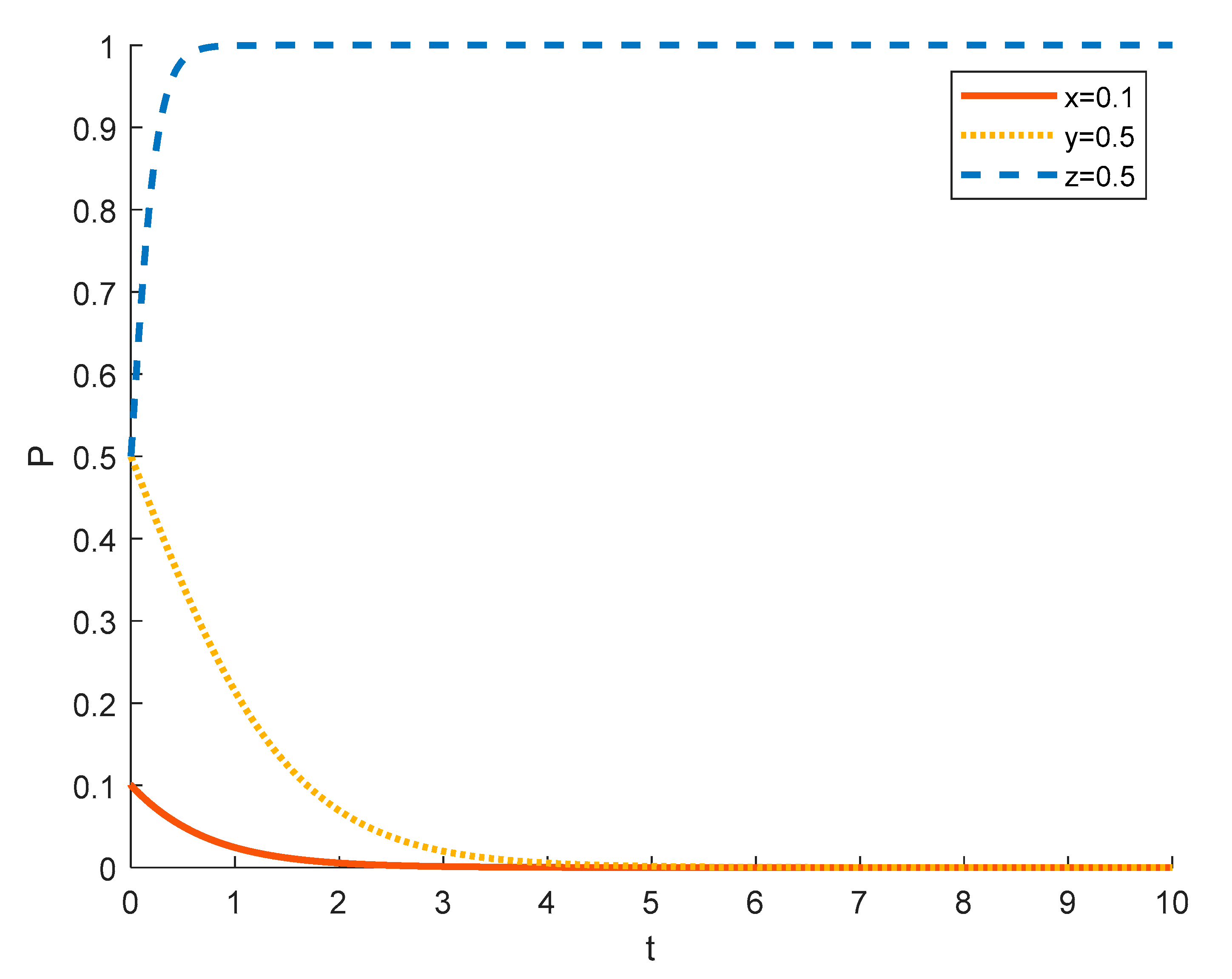
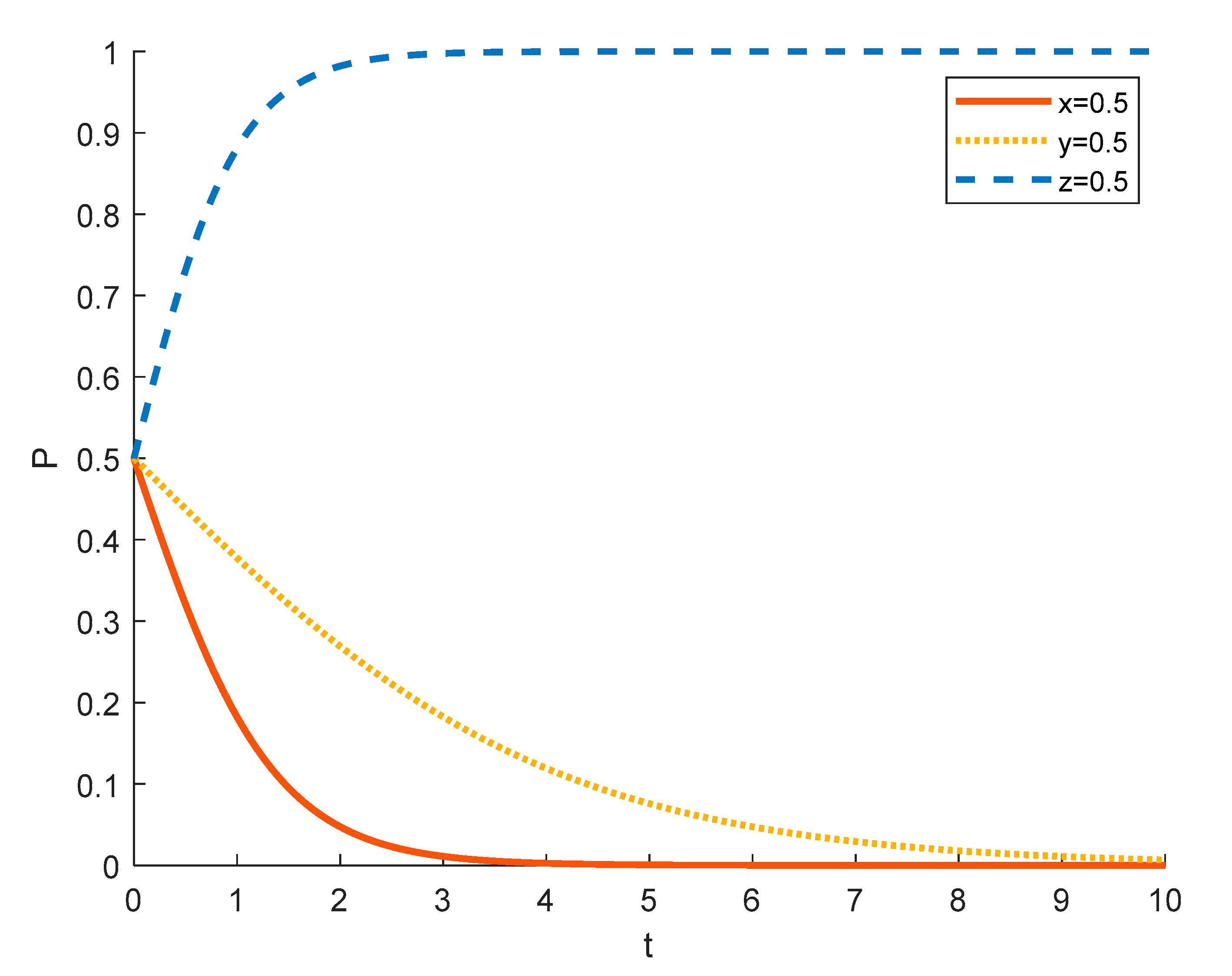
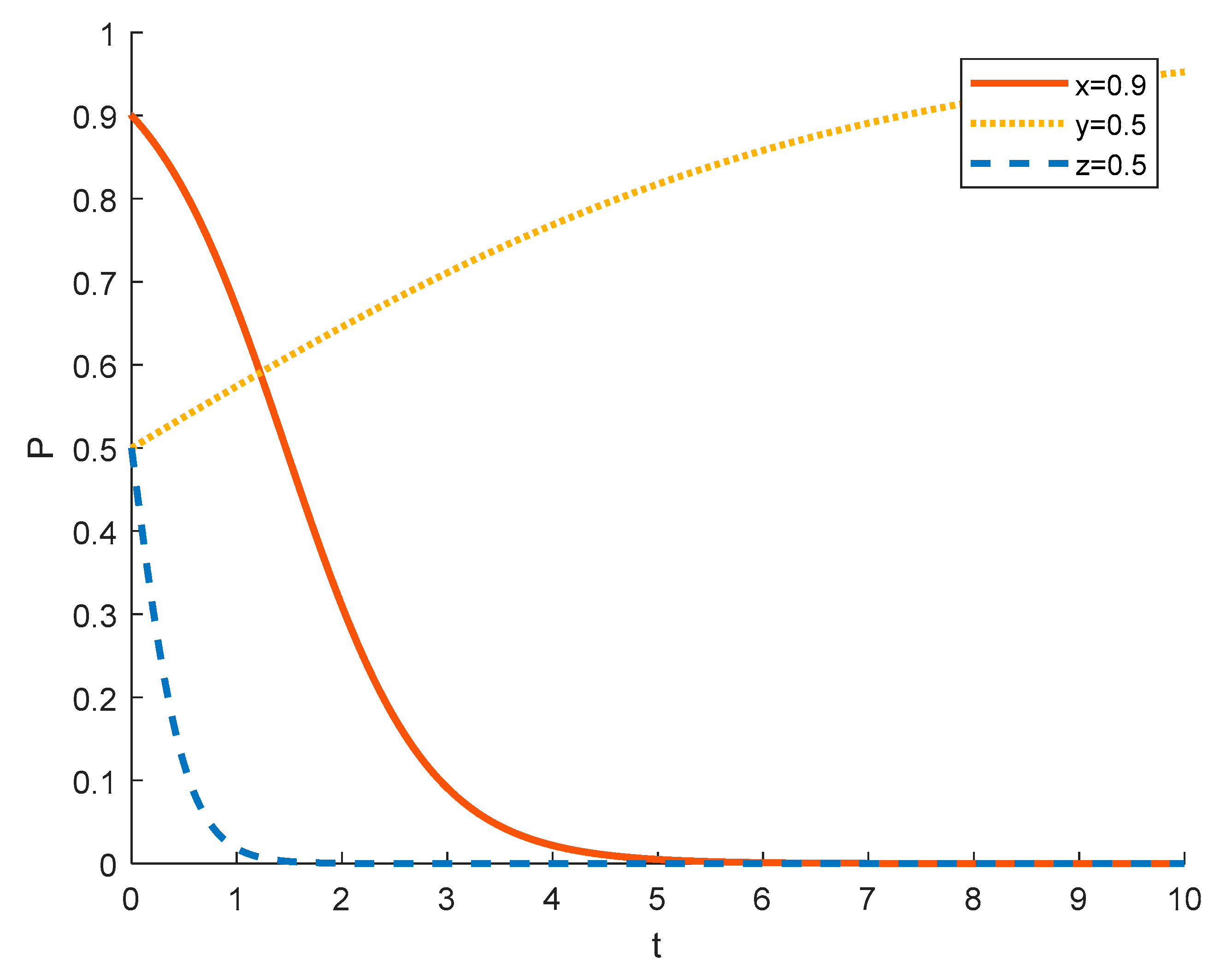
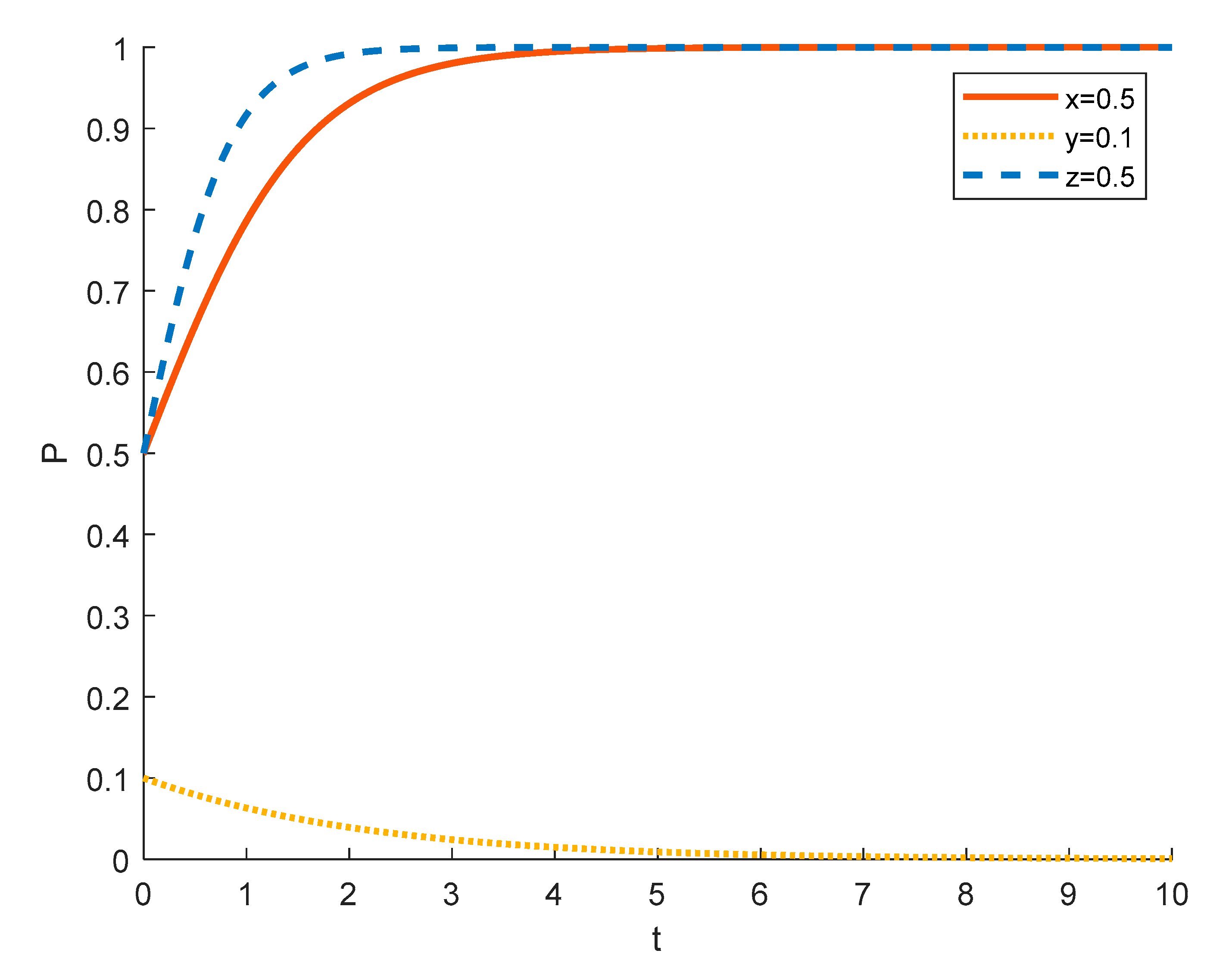
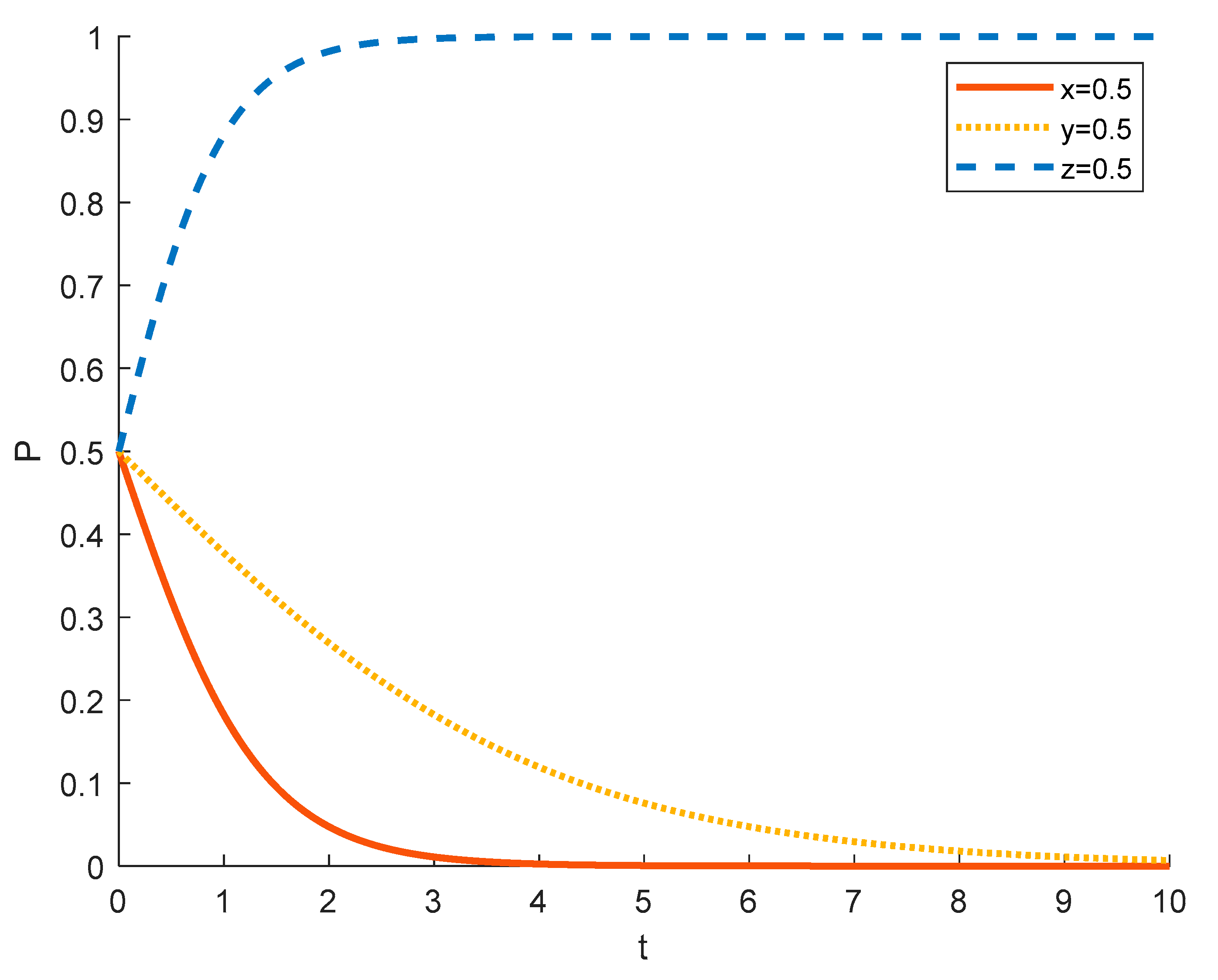
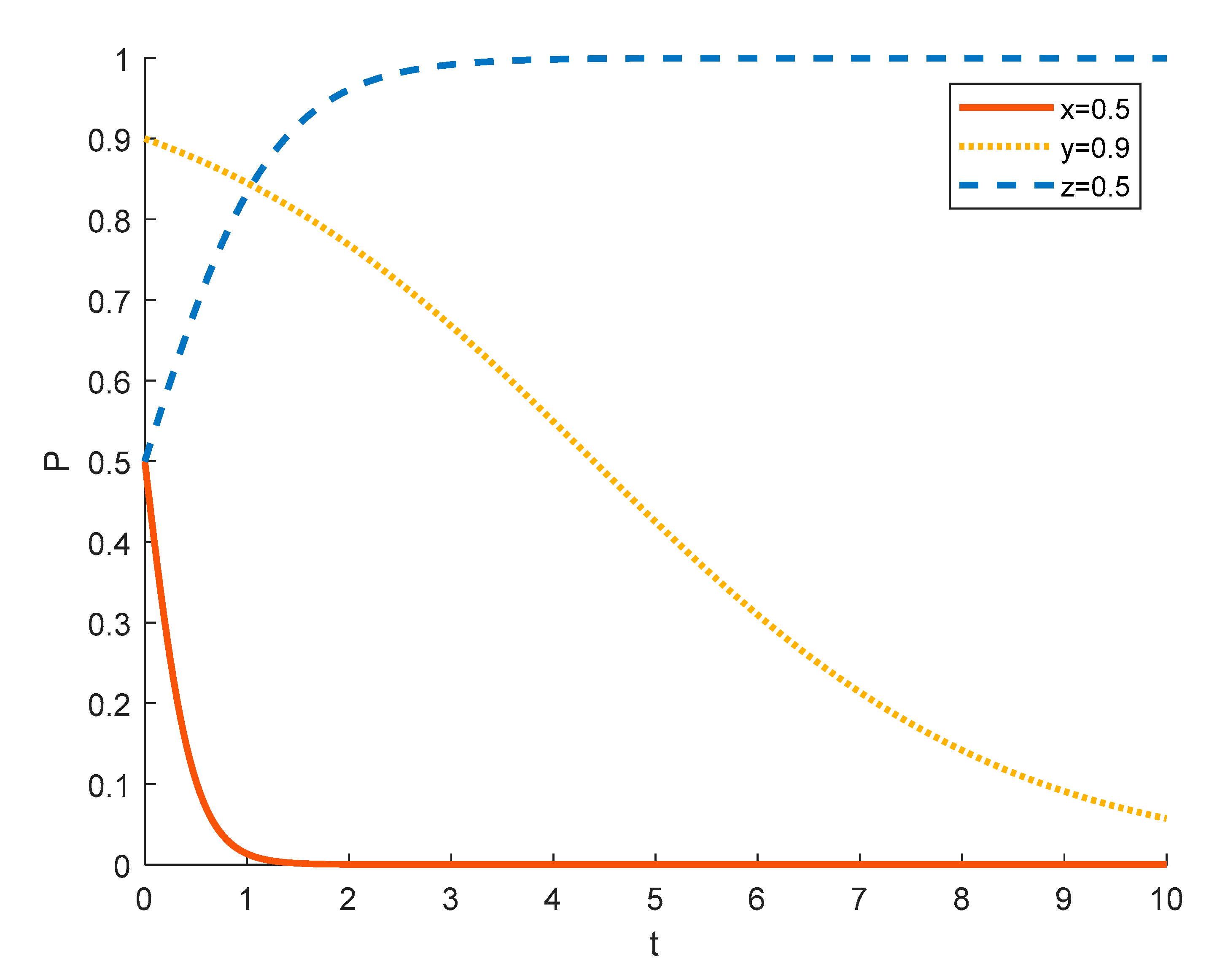
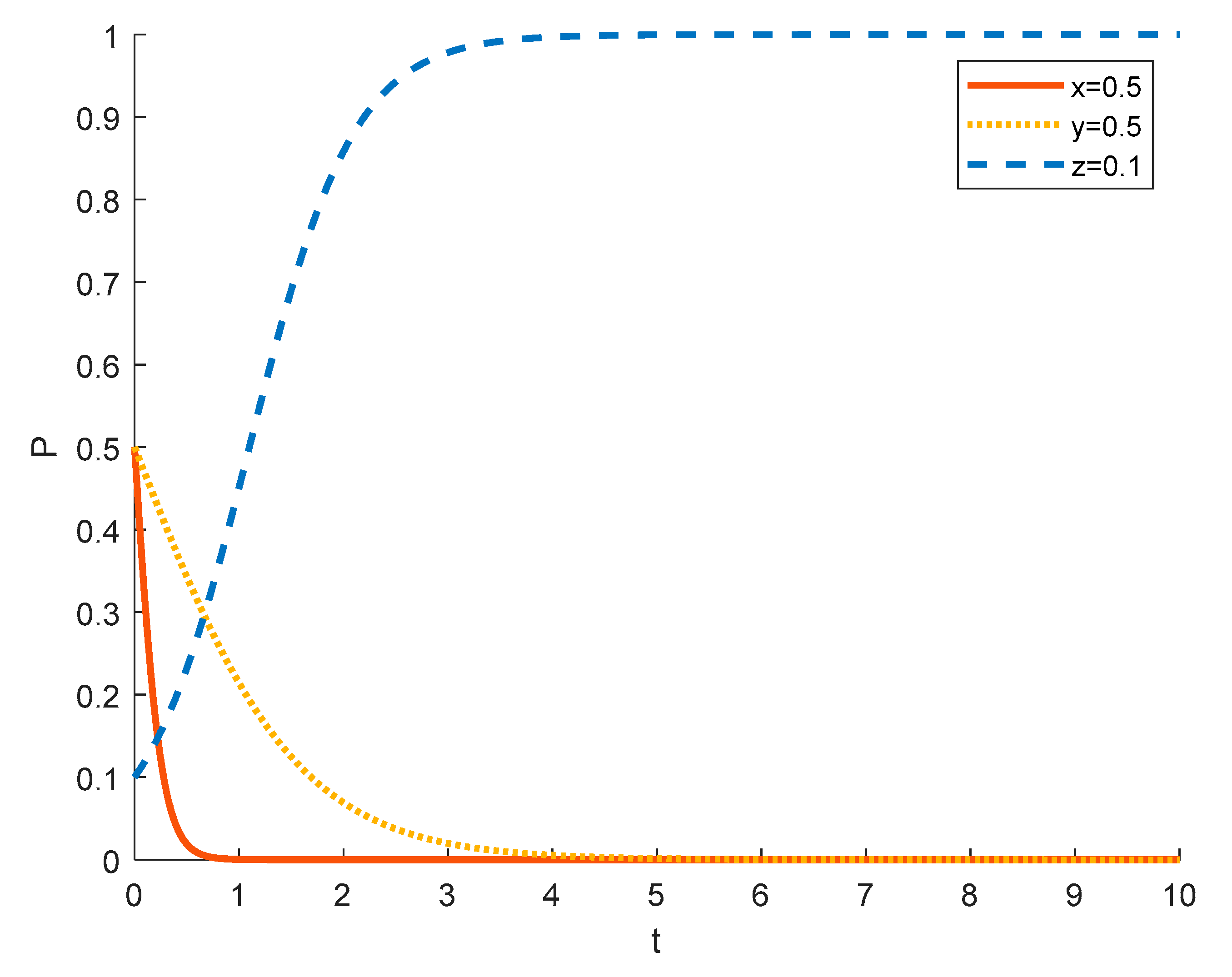
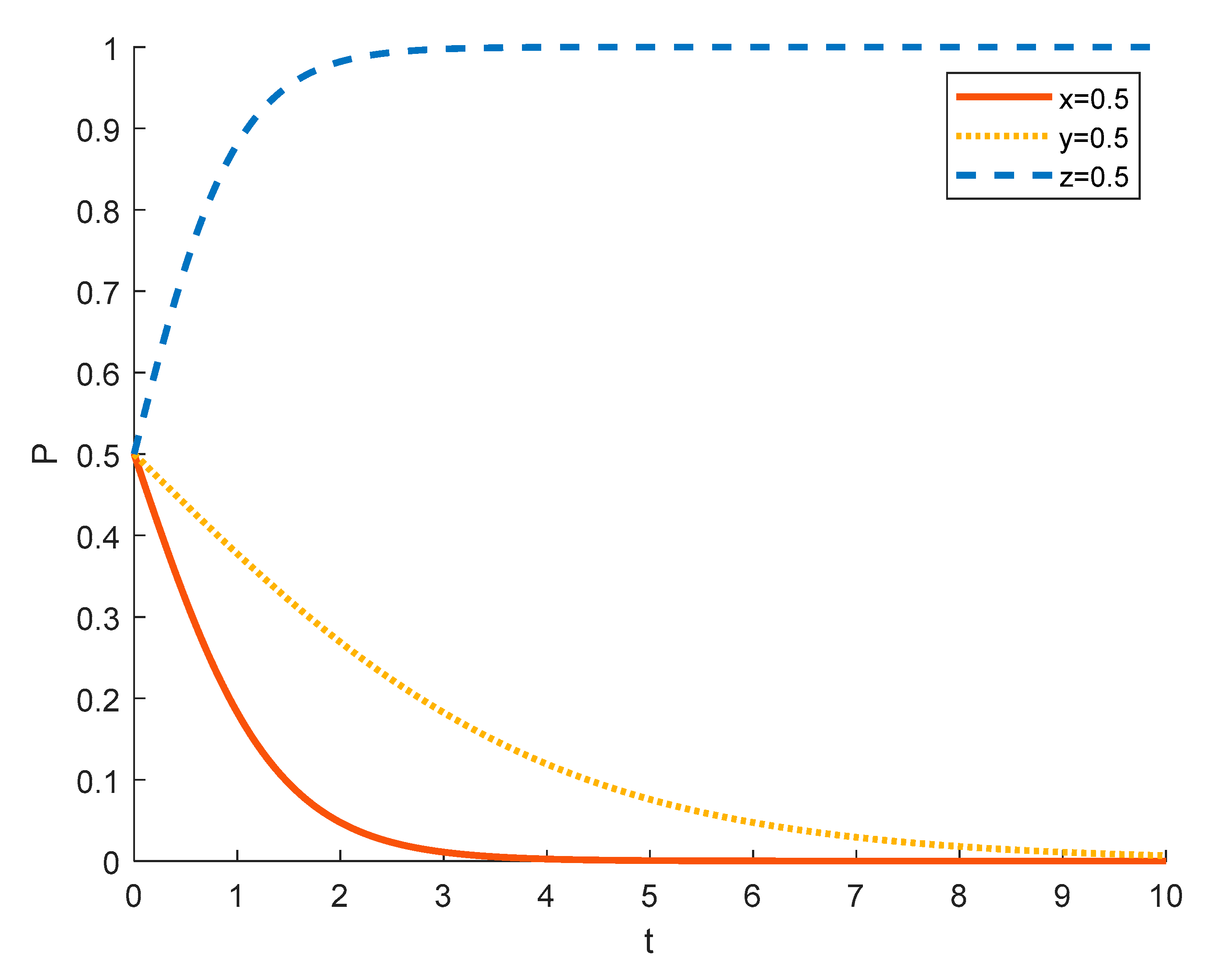
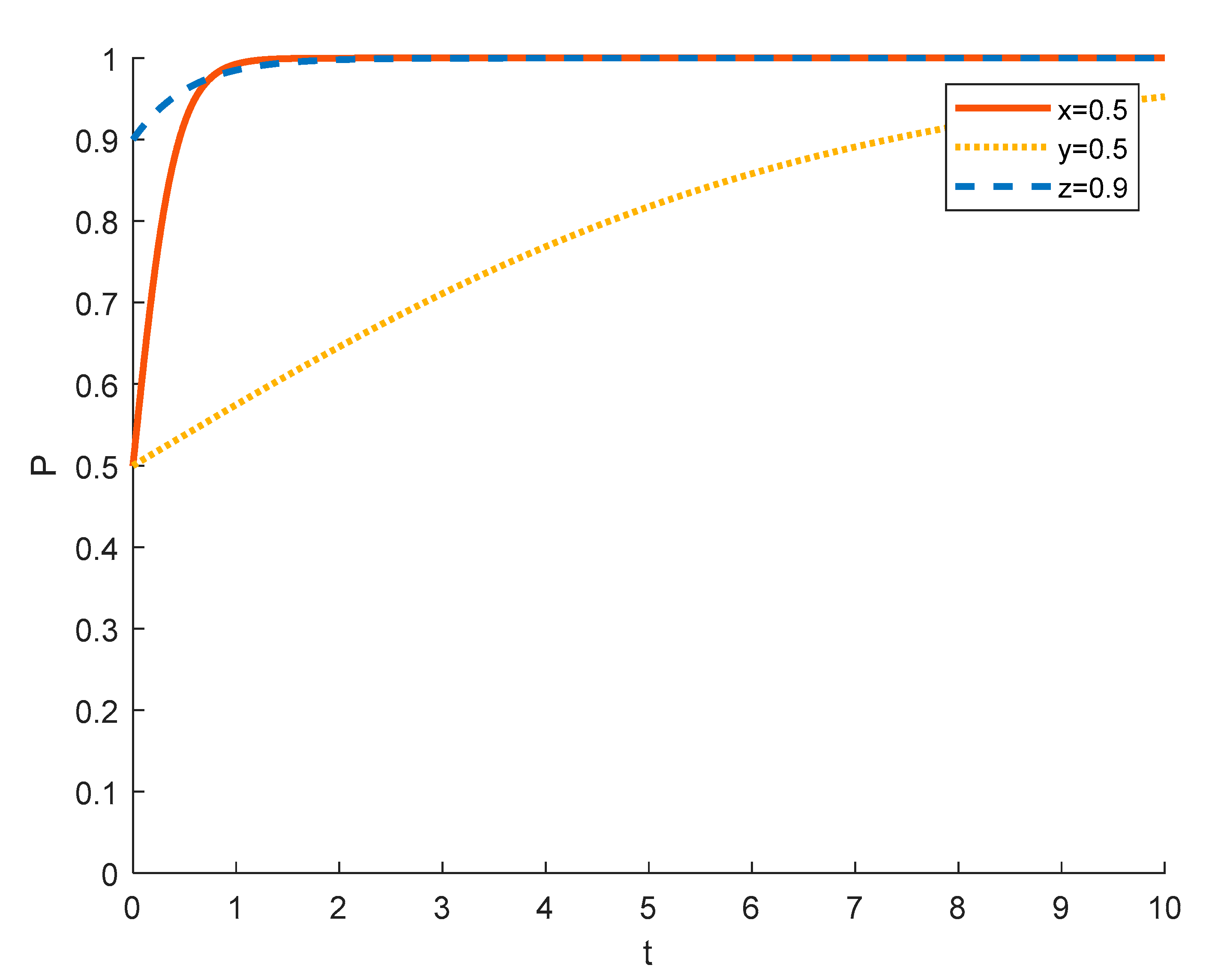
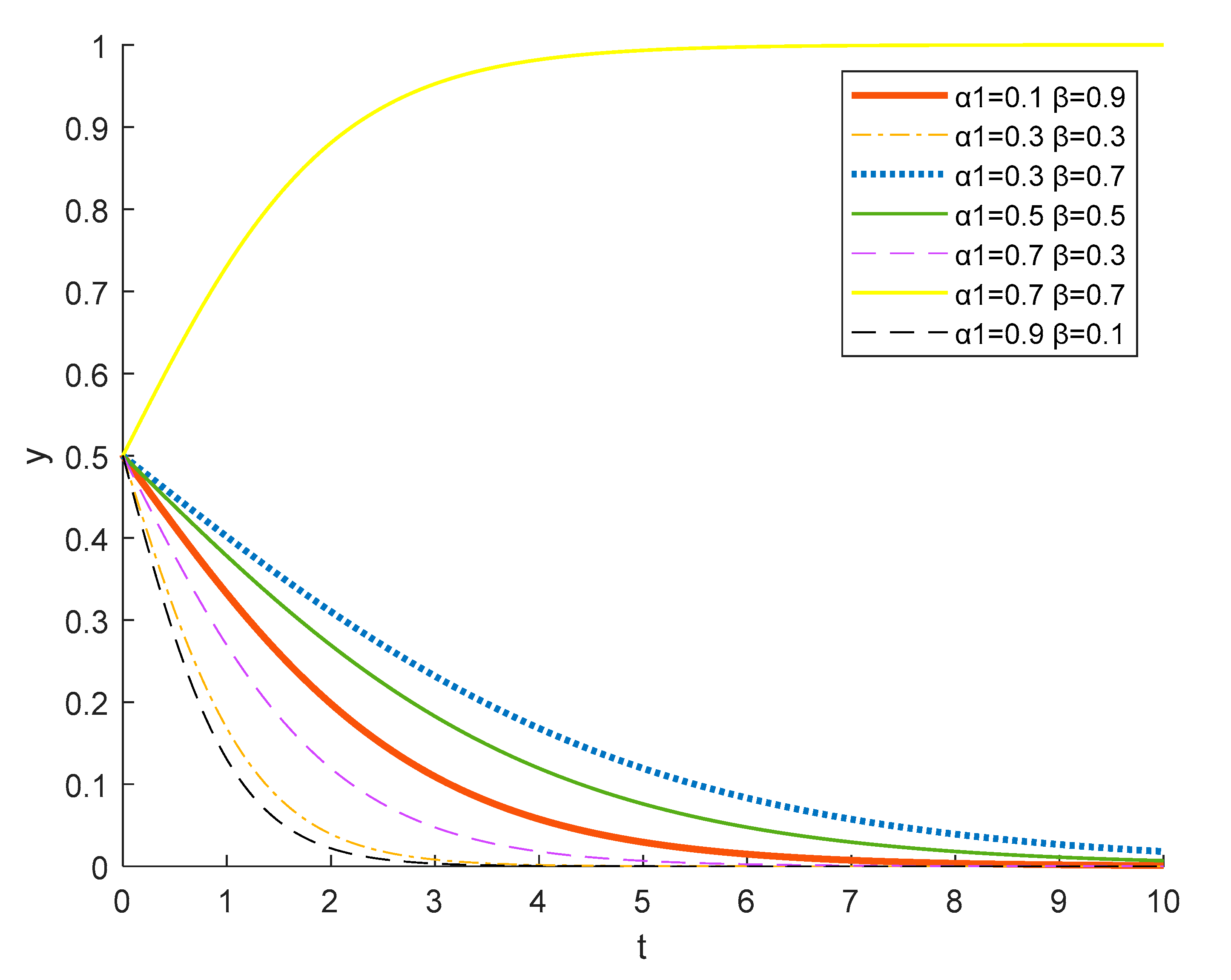
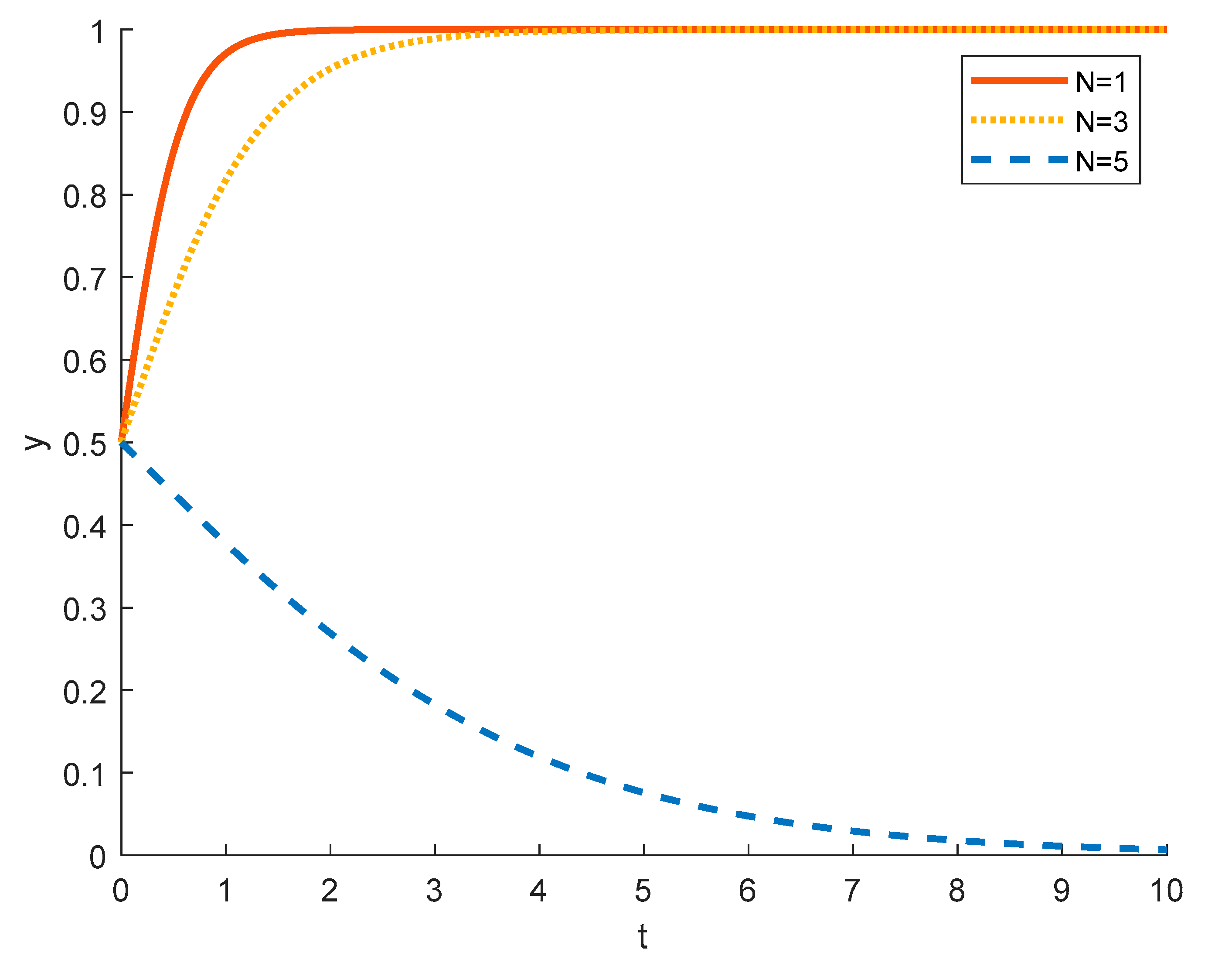
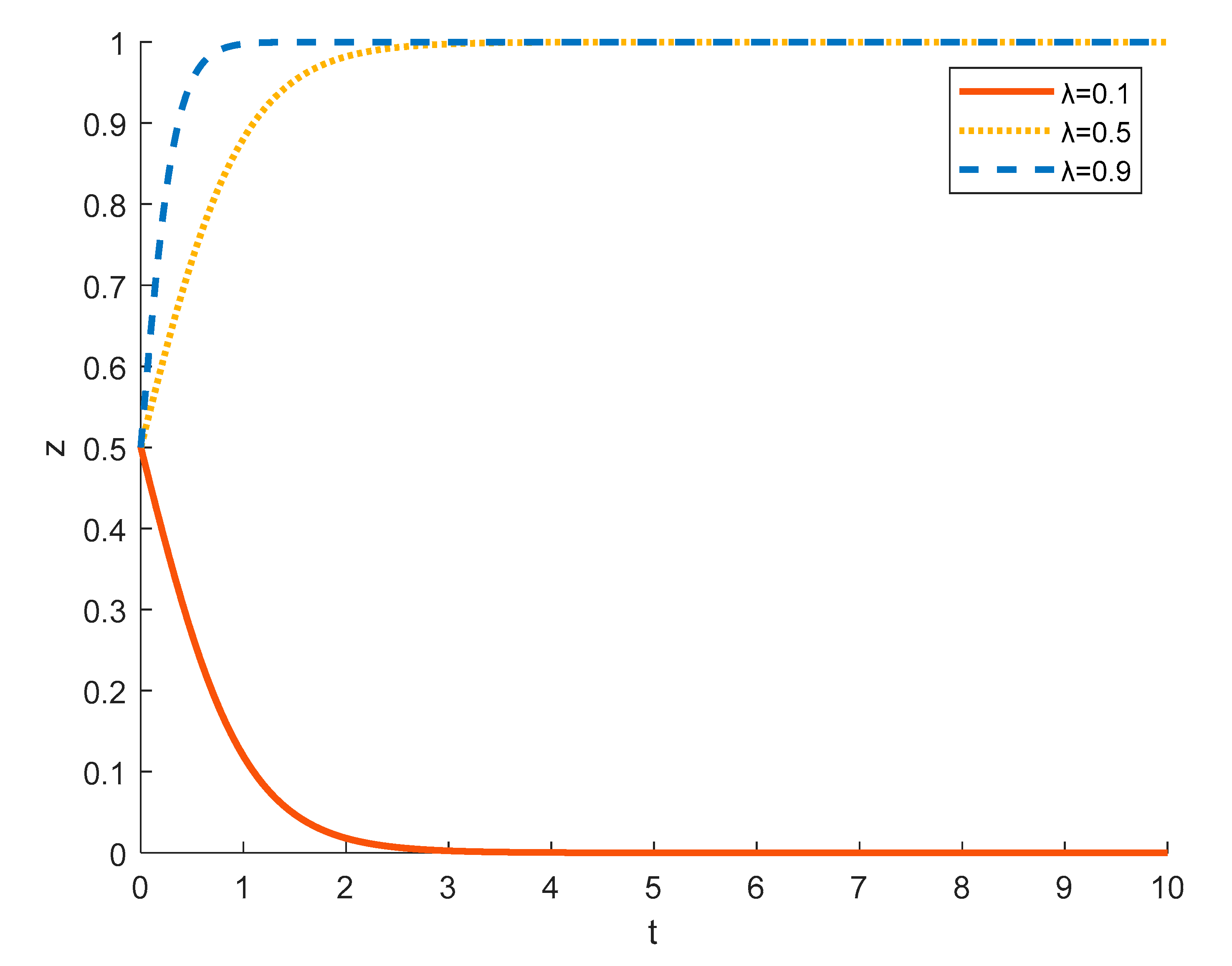
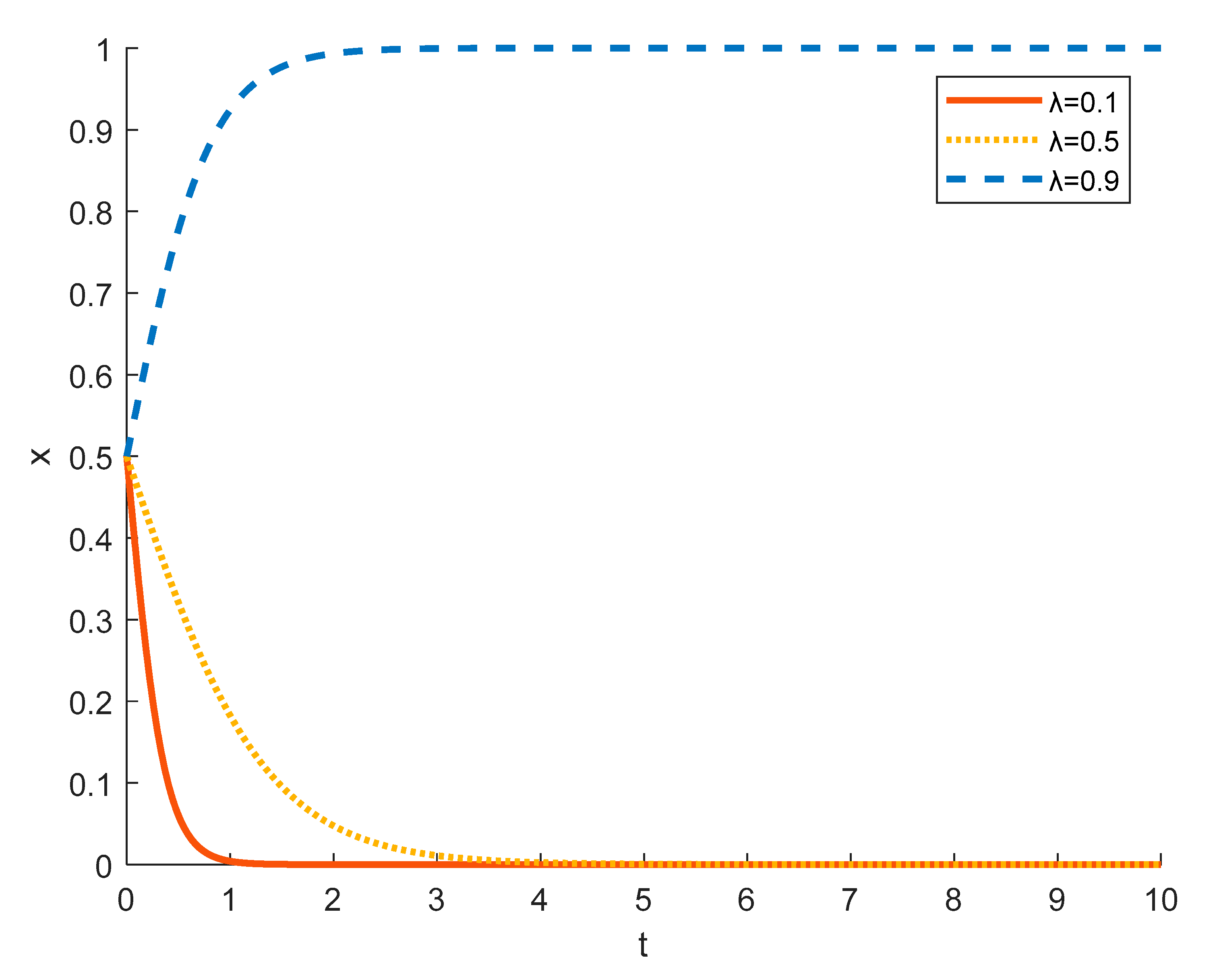
| Local Residents | |||
|---|---|---|---|
| Tourism enterprise substantive | Government strict regulation | Active participation | Negative participation |
| Government formal regulation | |||
| Tourism enterprise spurious | Government strict regulation | ||
| Government formal regulation | |||
Publisher’s Note: MDPI stays neutral with regard to jurisdictional claims in published maps and institutional affiliations. |
© 2021 by the authors. Licensee MDPI, Basel, Switzerland. This article is an open access article distributed under the terms and conditions of the Creative Commons Attribution (CC BY) license (https://creativecommons.org/licenses/by/4.0/).
Share and Cite
Sun, K.; Xing, Z.; Cao, X.; Li, W. The Regime of Rural Ecotourism Stakeholders in Poverty-Stricken Areas of China: Implications for Rural Revitalization. Int. J. Environ. Res. Public Health 2021, 18, 9690. https://doi.org/10.3390/ijerph18189690
Sun K, Xing Z, Cao X, Li W. The Regime of Rural Ecotourism Stakeholders in Poverty-Stricken Areas of China: Implications for Rural Revitalization. International Journal of Environmental Research and Public Health. 2021; 18(18):9690. https://doi.org/10.3390/ijerph18189690
Chicago/Turabian StyleSun, Keke, Zeyu Xing, Xia Cao, and Weijia Li. 2021. "The Regime of Rural Ecotourism Stakeholders in Poverty-Stricken Areas of China: Implications for Rural Revitalization" International Journal of Environmental Research and Public Health 18, no. 18: 9690. https://doi.org/10.3390/ijerph18189690
APA StyleSun, K., Xing, Z., Cao, X., & Li, W. (2021). The Regime of Rural Ecotourism Stakeholders in Poverty-Stricken Areas of China: Implications for Rural Revitalization. International Journal of Environmental Research and Public Health, 18(18), 9690. https://doi.org/10.3390/ijerph18189690






